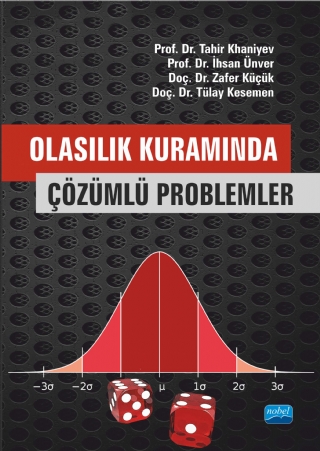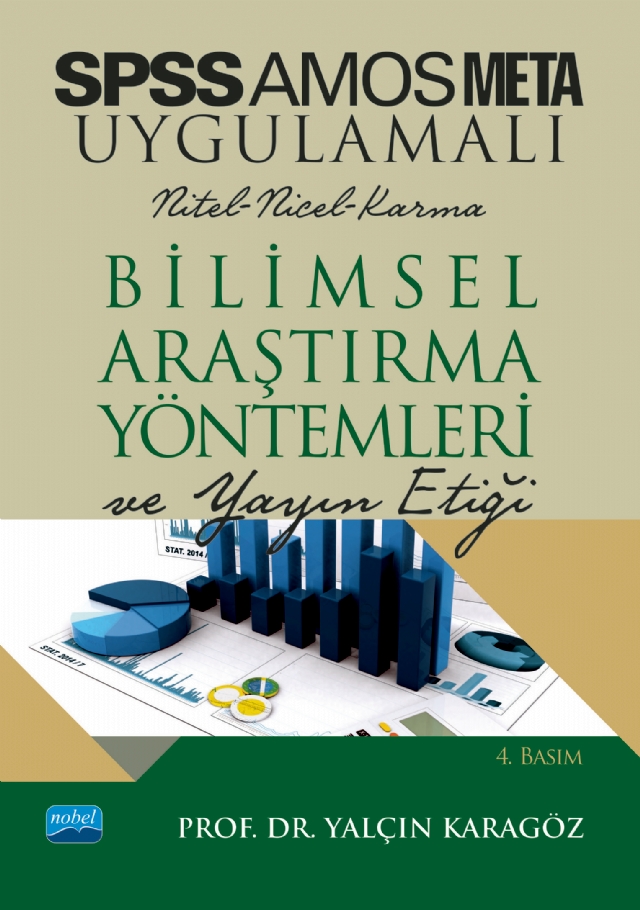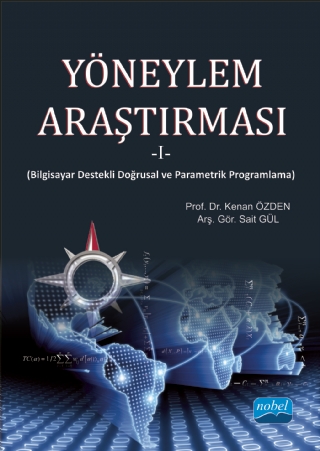Statistics and Actuarial \ 1-1

The way to reach accurate information in a scientific research is to collect as much error-free data as possible. This is only possible with the use of reliable and valid measurement tools developed using scientific methods. In this book, it is aimed to discuss the development processes of a reliable and valid measurement t...
Show more
This book is intended to explain to researchers how to perform multilevel regression models and analysis through the HLM program. In the first part of the book, which consists of four parts, the statistical foundations of multilevel regression models have been tried to be mentioned. In the ...
Show more
In order to produce an effective and rational solution to decision-making problems, the purpose of the task should be clearly formulated, a set of criteria should be defined, and the selected criteria should be weighted with the most appropriate method. It should be analyzed with scientific-based multi...
Show more
The fields of probability and statistics, which are widely used in many fields today, contain theorems that are difficult to understand and are complicated by students. Therefore, the aim of this book is; The aim is to teach probability and statistics fields more easily to students studying in all departments of universities, especially scien...
Show more
This book was created by blending the lecture notes used for years for the Differential Equations course taught in the Department of Mathematics, Faculty of Science, Ankara University, with the current literature, and rearranging them in the required width and depth in an original way. Consisting of fifteen chapters and 554 pages, th...
Show more
Today, one of the most important areas of interest in social sciences is empirical studies. As a methodological science, econometrics is in a position to guide a number of social sciences, especially economics, in terms of method.
It is thought that this book, which is prepared at a level that can be understood by undergraduate and graduate ...
Show moreIt is thought that this book, which is prepared at a level that can be understood by undergraduate and graduate ...

Probability and Statistics teaching aims to develop data collection tools for students to analyze real-life problems, to...
Show more
Statistics; It is an interdisciplinary science that facilitates collecting data, classifying data, making sense of it by analyzing, explaining, evaluating and interpreting data on a particular subject, making it easier to draw conclusions, obtain information and/or make decisions. Statistical methods...
Show more
This book has been prepared as a textbook for Finance Mathematics courses given in Economics, Business Banking, Finance and Actuarial departments of universities. It will be a resource book that can be used by candidates who will take the Capital Markets Board (CMB) Licensing exams and Actuarial exams.
The topics in the book were w...
Show moreThe topics in the book were w...

Although statistics is a very easy field to learn, the learner's own affective barriers can prevent learning. When we look at those who have problems in learning statistics, it is seen that most of these individuals have had negative experiences in numerical or statistics courses in the past.
This work, named Statistical, provides a ...
Show moreThis work, named Statistical, provides a ...

This course book has been prepared on the basis of the content of the courses taught under the name of Statistics, General Statistics and Introduction to Statistics in Education Faculties, Science and Literature Faculties and Vocational Schools (Health Vocational Schools).
In the first chapter, the concepts of statistics and graphics, seri...
Show moreIn the first chapter, the concepts of statistics and graphics, seri...

Imagine a product that you use a lot, and then think about the most important feature that determines the quality of that product for you. For example, this could be the life of the battery for a mobile phone. What would you say if you were told that none of the original batteries placed in the same brand and model product are exactly the...
Show more
Statistics is widely used in all fields of science and many business fields because software package programs have developed by following the...
Show more
In scientific research, it is important that the data analysis is done correctly, accordingly the findings are interpreted correctly and the results are delivered to the readers correctly. In this book, Ja...
Show more
This book, titled Modern Time Series and Methods, which was prepared with the motivation created by the lack and need of Turkish resources on the subject of contemporary time series methods, consists of nine chapters. The book, which is prepared in a way that can be used by both graduate students and anyone interested in the subject, i...
Show more
Structural equation modeling has become a frequently used methodology both in social sciences and other fields in recent years. This methodology can be used in analyzes such as scale development, examining the psychometric properties of the scale, measuring invariance, testing multivariate models, estimating direct and indirect effects, as wel...
Show more
simulation; It is a powerful tool for the design, modeling, analysis and optimization of systems and is one of the target technologies of the 21st century. This book is addressed to many different beneficiary groups, especially to engineering program students such as Industry and Mechanical engineering, where Si...
Show more
This book includes quantitative, qualitative and mixed method research designs and statistics. Book; introduction to research, research problem, hypotheses and variables, measuring variables, universe and sample, quantitative research designs; single-subject studies; internet-based research; data collection methods, observation, questi...
Show more
In this book titled "Solution Problems in Probability Theory", we have included the original problems we have created as well as the problems in Turkish, Azerbaijani, English and mostly Russian sources. Our main aim in this study is to enrich students' mathematical thinking structures by enablin...
Show more
This textbook, which was written for undergraduate and graduate students, covers the second part of the "Probability and Statistics" course taught at universities, statistics and applications.
Book; It has been prepared by taking into account the concepts, basic theoretical issues and sample problems for application, whi...
Show moreBook; It has been prepared by taking into account the concepts, basic theoretical issues and sample problems for application, whi...

Success in statistics is closely related to statistical thinking, reasoning using the rules of statistics, and being able to establish a relationship between the principles and operations of statistics an...
Show more
With this book, the researcher; will be able to analyze and interpret the results by looking only at the subject of interest, without examining the entire book. This book has been prepared for undergraduate, graduate and especially scientific research. Regarding the subjects, the examples were solved first theoretically and then with SPSS...
Show more
This book; specially prepared for scientific research. The examples related to the subjects were solved first theoretically and then with SPSS, AMOS and META package program. A researcher who wants to do statistical analysis; will be able to analyze and interpret the results by looking only at the subject of interest without examining the...
Show more
This book has been prepared for undergraduate, graduate and especially scientific research. In this book, in quantitative, qualitative and mixed research, how the research process (determining the research problem, establishing hypotheses, determining the sampling method, data collection, reliability, validity, analysis of the data, evalu...
Show more
Today, time series or similar courses are taught in economics, business, health and engineering departments of universities. Researchers doing postgraduate education in these departments are much more interested in time series. The most important reason for this is observing how a series of variables change over time, wondering how these var...
Show more
In the author's 6-book statistics series, this book, which is an introduction to statistics and addresses the basic concepts of statistics, probability and probability distributions, appealing to a wide audience and in a plain language, has been updated and presented to the readers after the first edition has been exhausted and a new p...
Show more
Today, many different statistical processes have become an integral part of test development processes in order to examine the qualities that measurement tools should have. With the widespread use of measurement tools, these procedures have been accepted as a "standard" for many researchers. In particular, confirmatory factor analysis and expl...
Show more
Today, econometrics has become one of the indispensable analysis tools of economics. All kinds of approaches within the scope of economic theory are subject to econometrics. One of the most important reasons for this is that this branch of science is increasingly dealing with numbers, and the second is the rapid development in computer techn...
Show more
The book presented by the author to the members of the jury as a “Professor Presentation” is the first of the 6-book Statistics Series. "Regression and Correlation Analysis", which is one of the most fundamental subjects of "statistics", which in a sense forms the basis of "Multivariate Statistical Methods", is discussed in detail in t...
Show more
Many useful methods for data analysis have been developed in the field of statistics, and most of these methods are ready and waiting to be used in R. Interest in R language(m) is increasing day by day as it makes it possible to access many resources and data on the internet. The data to be used in practice is also very important, e...
Show more
In today's world, billions of data are produced every second. However, due to the abundance of data produced, today's age is called the "Big Data Age" or "Information Age". Transforming data into information in a qualified sense is of...
Show more
The purpose of this book is to help students studying in the departments of Industrial, Business and Systems Engineering, Business Administration, Economics, Econometrics and Mathematics in universities and Military Academy, regarding the effective, economic and efficient use of resources such as human, material and machinery for b...
Show more
In the book named Time Series and Forecasting Methods; All forecasting methods, from basic to advanced, are introduced with R applications. The book has been prepared with the intention of being a bedside book for researchers who want to train themselves as predictors and practitioners who need foresight methods. In the book, su...
Show more

